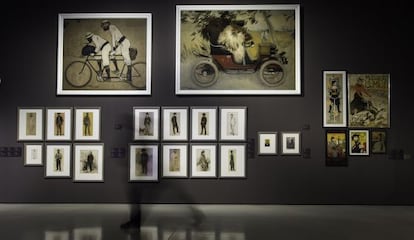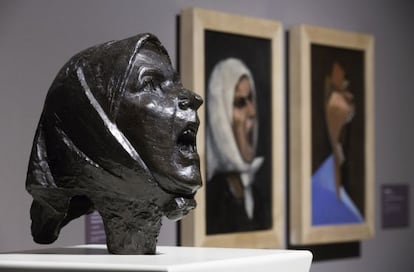MNAC’s modernist makeover
The Barcelona museum has carved out space to display its magnificent collection of 20th-century art


The National Art Museum of Catalonia (MNAC) in Barcelona is best known for its medieval art, particularly its collection of Romanesque murals, which is considered one of the most important in the world. But a significant chunk of the museum’s holdings of around 30,000 pieces is modern art, dating back to the beginning of the last century, and up to the 1950s. Now, around 1,300 pieces, half of them never exhibited in public before, are to go on display in a specially prepared space covering 4,000 square meters of the museum’s first floor.
The walls of the space, formerly a neutral off-white, have been painted in bright colors, while the paintings have been hung seemingly willy-nilly.
One of the MNAC’s main tasks is to showcase Catalan art through the centuries, but the collection now on display also includes work by Juan Gris, Julio Romero de Torres, Alfred Sisley and Edvard Munch. “These all form part of the collection and help to put it in context,” says the museum’s director, Pepe Serra.
We’ve presented a big picture of what society was like, with all its contradictions” MNAC director Pepe Serra
When Serra took over three years ago, he made it clear that he wanted to break with tradition, and put the modern art collection in context. As a result, painting, sculpture, posters, cinema, illustrations, furniture, advertising, photography, and particularly architecture are all on display. Together the pieces tell the story of the beginning of modern art, and how realism gradually emerged as the dominant trend in the early 20th century. Paintings such as Mariano Fortuny’s The Battle of Tetuán, which harks back to the styles of the 19th century, become superseded by more lifelike depictions of events.
The exhibition brings the period to life through the faces of the artists as depicted in their self-portraits, as well as those of their wealthy patrons. “We have tried to avoid focusing on styles such as Impressionism, Futurism, Cubism, Expressionism, etc., and have instead presented a big picture of what society was like, with all its contradictions,” says Serra. “The major works are there as well, and are enriched by being seen alongside others created at that time.”
The longer-term goal, says Serra, is for the MNAC to become the benchmark for modernism, a movement that developed in Catalonia, represented by artists and architects such as Ramon Casas, Santiago Ruisiñol, Miquel Utrillo, Isidre Nonell, Pablo Picasso and Carles Casagemas. Space has been found to present 20 pieces of furniture created by Antoni Gaudí, alongside work by his long-time collaborator Josep Maria Jujol.

Works by Juli González, Joaquim Sunyer, Josep de Togores, Joaquim Torres-García, Salvador Dalí and Picasso are all to be found in the 39 sections that make up the collection. There are also pieces related to the Spanish Civil War, among them photographs taken by Agustí Centelles, many of which were exhibited alongside Picasso’s Guernica in the Republican Pavilion at the Exposition Internationale des Arts et Techniques dans la Vie Moderne in Paris in 1937.
An epilogue is provided in the form of works lent by the Barcelona Museum of Contemporary Art (MACBA) by Antoni Tápies, Modest Cuixart and Joan Ponç, members of the Dau al Set, which attempted to revive surrealism in Spain at the end of the 1940s. “Despite having 4,000 square meters at our disposal, we ran out of space,” says Serra, who says the Baroque and Renaissance areas of the museum are now to be redesigned.
Tu suscripción se está usando en otro dispositivo
¿Quieres añadir otro usuario a tu suscripción?
Si continúas leyendo en este dispositivo, no se podrá leer en el otro.
FlechaTu suscripción se está usando en otro dispositivo y solo puedes acceder a EL PAÍS desde un dispositivo a la vez.
Si quieres compartir tu cuenta, cambia tu suscripción a la modalidad Premium, así podrás añadir otro usuario. Cada uno accederá con su propia cuenta de email, lo que os permitirá personalizar vuestra experiencia en EL PAÍS.
¿Tienes una suscripción de empresa? Accede aquí para contratar más cuentas.
En el caso de no saber quién está usando tu cuenta, te recomendamos cambiar tu contraseña aquí.
Si decides continuar compartiendo tu cuenta, este mensaje se mostrará en tu dispositivo y en el de la otra persona que está usando tu cuenta de forma indefinida, afectando a tu experiencia de lectura. Puedes consultar aquí los términos y condiciones de la suscripción digital.
Últimas noticias
Maduro pleads not guilty before the federal court in New York: ‘I am still the president of Venezuela’
A new test can detect Alzheimer’s from a finger prick
UN team enters Sudanese city of El Fasher after paramilitary massacre: ‘It’s like a ghost town’
A recipe for resistance: Indigenous peoples politicize their struggles from the kitchen
Most viewed
- Gilles Lipovetsky: ‘If you want to live better and fall in love, take Prozac, don’t look to philosophy’
- Alain Aspect, Nobel laureate in physics: ‘Einstein was so smart that he would have had to recognize quantum entanglement’
- Alvin Hellerstein, a 92-year-old judge appointed by Bill Clinton, to preside over Maduro’s trial in New York
- Maduro’s downfall puts China’s relationship with Venezuela to the test
- Why oil has been at the center of Venezuela-US conflicts for decades








































